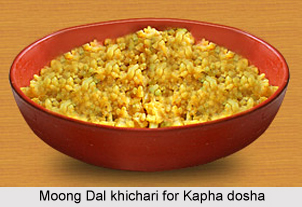 Moong dal khichdi is a rice preparation which is loaded with various health benefits. The recipe is light and easy to digest hence it is quite popular amongst the people who follow ayurvedic diet practices. This recipe is good for all dosha (tridoshic) but mainly beneficial for Kapha dosha. Basmati rice, yellow split moong dal, ghee, bay leaves, cinnamon bark, cloves, cardamom pods, and salt are the main ingredients for preparing this dish. It is easy to cook and can be prepared even at home.
Moong dal khichdi is a rice preparation which is loaded with various health benefits. The recipe is light and easy to digest hence it is quite popular amongst the people who follow ayurvedic diet practices. This recipe is good for all dosha (tridoshic) but mainly beneficial for Kapha dosha. Basmati rice, yellow split moong dal, ghee, bay leaves, cinnamon bark, cloves, cardamom pods, and salt are the main ingredients for preparing this dish. It is easy to cook and can be prepared even at home.
Ingredients of Moong Dal Khichdi for Kapha Dosha
•One-cup basmati rice
•One-cup yellow split moong dal
•Three tablespoonful of ghee
•Four bay leaves
•Four small pieces of cinnamon bark
•Four whole cloves
•Four whole cardamom pods
•Six cups of water
•One-fourth teaspoonful of salt
Method of Preparing Moong Dal Khichdi for Kapha Dosha
•Wash the rice and mong dal before soaking them in water for at least two hours before cooking.
•Heat a saucepan on medium flame and then add ghee.
•When hot, put the bay leaves, cinnamon, cloves and cardamom and stir until the spices blend well and give out an aroma.
•Mix the rice, dal, salt and water and boil at a low flame uncovered for five minutes. Cover and cook on low heat for nearly twenty five to thirty minutes until the dal and rice have softened
•Serve hot.
Benefits of Moong Dal Khichdi for Kapha Dosha
This healthy yet delicious dish ensures lots of benefits which are as follows:
•Since, it is made using a range of herbs and spices; it is capable of healing various diseases.
•Owing to its ease of digestion and assimilation, it is also preferred in Ayurvedic cleansing therapy.
•It can be consumed by anyone with any type of doshas but is especially good for vata.
Moong dal khichdi for kapha dosha is generally consumed as a single dish. It can also be teamed up with a mixed vegetable dish, ghee or salad. This nutritious dish can be eaten both as lunch and dinner food item.





